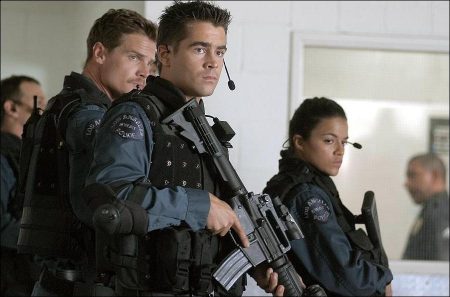Taglines: You’re either S.W.A.T. or you’re not.
S.W.A.T. movie storyline. Based on the 1970s TV series of the same title, this film follows a squad of Los Angeles’ Special Weapons and Tactics assigned to protect a drug kingpin who has offered a $100 million reward to anyone who can free him. Samuel L. Jackson plays a grizzled S.W.A.T. veteran who’s in charge of the venture.
S.W.A.T. is a character-driven action-adventure built around a story of redemption, about men and women whose mission is to defuse the most volatile situations faced by policemen in the line of duty. S.W.A.T. is also a study in personality contrasts and how they shape an individual’s destiny. Two devoted S.W.A.T. officers, Jim Street (Colin Farrell) and his partner, Brian Gamble (Jeremy Renner), are reprimanded and demoted after making a controversial call during a bank robbery and hostage crisis. Gamble quits the L.A.P.D. in disgust rather than submit to punishment, while Street decides to stay on, laying low, hoping for another shot someday. Their respective decisions will alter the course of their lives.
For Street, the demotion becomes a path to salvation when he meets Sergeant “Hondo” Harrelson (Samuel L. Jackson), who has returned to S.W.A.T. from another division with a mandate to create a new team. Like Street, his motive is to redeem his past. His longtime nemesis, Capt. Thomas Fuller, is doing everything in his power to ensure that Hondo fails. As with Street, Hondo refuses to let detractors get in his way. He doggedly moves forward, putting together the best team the L.A.P.D. has to offer.
All About the Real S.W.A.T.
The L.A.P.D.’s S.W.A.T. team was the originator of tactical teams for municipal law enforcement. After several sniping incidents against civilians and police officers around the country, many of which occurred in Los Angeles during and after the Watts Riots in the late 1960s, it was acknowledged that an adequate response to such situations did not exist. Consequently, voluntary units called station defense teams, consisting of officers with specialized experience and prior military service, were created.
S.W.A.T (Special Weapons And Tactics Team) was initiated in the late 1960s, and formalized in 1972 by the Los Angeles Police Department, in recognition of the need and advantage of collectively training a full-time unit within the Metropolitan Division.
Innovative for its time, the unit brought cohesion to the way police handled special tactical events. It has since become legendary among law enforcement agencies worldwide. At present, S.W.A.T. is an elite unit consisting of approximately 60 L.A.P.D. officers, six sergeants and one lieutenant, all of whom are expertly trained tactical assault specialists. The unit covers all 18 geographical areas, or divisions, of Los Angeles, a city that spans almost 500 square miles.
S.W.A.T., however, remained under-funded until the 1984 Olympic Committee became involved. Because the Olympic Games in Los Angeles was seen as a potential terrorist target, S.W.A.T. was infused with the necessary funding for the additional equipment and training required to provide adequate counter-terrorism protection. The Los Angeles Olympics went off without incident, but the funding and training initiated by the Games was a turning point for both the L.A.P.D. and S.W.A.T.
Following the success of the L.A.P.D.’s S.W.A.T. organization, other cities throughout the United States and the world have created similar units. Although not all of them are called S.W.A.T., and not all are under the auspices of a municipal police force (some are under federal or armed services jurisdiction), all share the same tactical objective.
As an elite unit, S.W.A.T. members are held up to rigorous physical and professional standards. Applicants are chosen from among those who have successfully made it onto the Metropolitan Division after a minimum of four years on the L.A.P.D. After one year at Metro, officers may apply to S.W.A.T., at which time they submit to an extremely demanding two-week trial process. Those who pass the tests are then put on a list from which the final candidates are selected. In any given year, about 50 officers apply. Only 8 to 10 make it into S.W.A.T.
Once they have been accepted, officers embark on an intensive seven-week training program. All S.W.A.T. members are cross-trained, but many also choose a specialty – e.g. snipers, long riflemen, etc. Some opt to train as negotiators. Currently, there are 18 S.W.A.T. officers who specialize in negotiation. Following their training, officers must wait for an opening before officially joining the team, though they are often invited to assist in tactical situations when extra manpower is required.
While some officers make a career of S.W.A.T. — the longest length of service has been 27 years — the average tenure on the unit is 8 to 12 years, after which most officers are promoted to other areas within the L.A.P.D.
In any given crisis situation, a minimum of 14 S.W.A.T. officers, one tactical sergeant and one negotiator sergeant are deployed. In addition to their tactical duties, S.W.A.T. also handles crisis negotiations with barricaded suspects. Many are also hostage situations. Notwithstanding the unit’s name and its members’ reputation as sharpshooters, the goal of any S.W.A.T. mission is to save lives. In handling approximately 80 barricaded suspect incidents and 50 high-risk warrants a year – more than 3,000 high-risk missions over the past three decades – LAPD’S S.W.A.T. team has, to this day, never lost a hostage.
S.W.A.T. (2003)
Directed by: Clark Johnson
Starring: Samuel L. Jackson, Colin Farrell, Michelle Rodriguez, Jeremy Renner, Olivier Martinez, Josh Charles, Page Kennedy, Ken Davitian, Larry Poindexter, Jeff Wincott
Screenplay by: David Ayer
Production Design by: Mayne Berke
Cinematography by: Gabriel Beristain
Film Editing by: Michael Tronick
Costume Design by: Christopher Lawrence
Set Decoration by: Casey Hallenbeck
Music by: Elliot Goldenthal
MPAA Rating: PG-13 for violence, language, sexual references.
Distributed by: Columbia Pictures
Release Date: August 8, 2003
Views: 187






